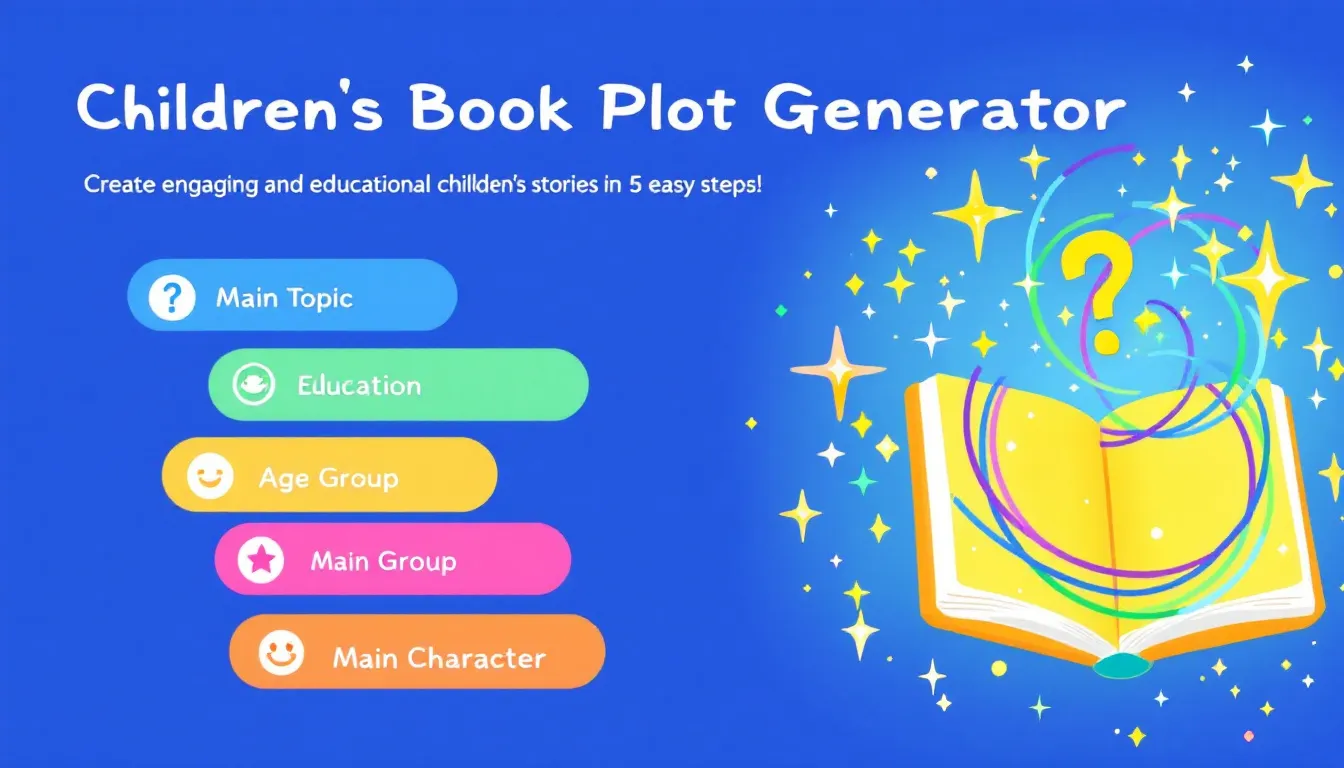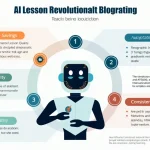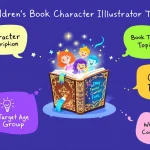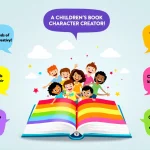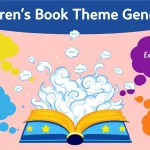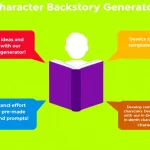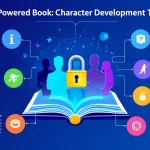Children's Book Plot Generator
Generating plot structure...
Is this tool helpful?
How to Use the Children’s Book Plot Structure Generator Effectively
To make the most of our Children’s Book Plot Structure Generator, follow these simple steps:
- Enter the main topic or theme: In the first field, input the central theme or subject of your children’s book. For example, you might enter “Space Exploration” or “Environmental Conservation”.
- Specify the target age group: Indicate the age range of your intended readers in the second field. This could be “3-6 years” or “10-13 years”, depending on your target audience.
- Describe the main character(s) (Optional): If you have a specific character in mind, briefly describe them in the third field. For instance, “A curious alien child” or “A group of eco-friendly forest animals”.
- Include an educational element (Optional): In the fourth field, you can specify any educational content or moral lesson you want to incorporate, such as “Learning about planet names” or “The importance of recycling”.
- Generate the plot structure: Click the “Generate Plot Structure” button to create your customized story outline.
- Review and copy the results: Once generated, review the plot structure in the results section. If you’re satisfied, use the “Copy to Clipboard” button to save it for further development.
By providing clear and specific inputs, you’ll receive a more tailored and inspiring plot structure for your children’s book project.
Unleashing Creativity: The Power of the Children’s Book Plot Structure Generator
Welcome to the world of imaginative storytelling! Our Children’s Book Plot Structure Generator is a powerful tool designed to spark creativity and provide aspiring authors with a solid foundation for crafting engaging narratives for young readers. This innovative tool combines the art of storytelling with educational elements, helping you create captivating tales that not only entertain but also impart valuable lessons to children.
Whether you’re an experienced author looking for fresh ideas or a newcomer to the world of children’s literature, this generator offers a structured approach to developing compelling plot outlines. By inputting key elements such as the main theme, target age group, and optional character descriptions, you’ll receive a customized plot structure that serves as a springboard for your storytelling journey.
The Essence of Effective Children’s Literature
Creating a successful children’s book involves more than just putting words on paper. It requires a deep understanding of your young audience, a keen sense of pacing, and the ability to weave educational elements seamlessly into an engaging narrative. Our plot structure generator takes these factors into account, providing you with a framework that addresses the unique needs of children’s literature.
Tailored Storytelling for Different Age Groups
One of the key features of our generator is its ability to adapt to different age groups. The plot structure for a book aimed at preschoolers (ages 3-5) will differ significantly from one targeted at middle-grade readers (ages 8-12). By specifying your target age group, you ensure that the generated plot structure aligns with the cognitive abilities, interests, and attention spans of your intended audience.
Incorporating Educational Elements
Children’s books often serve as powerful tools for learning and personal growth. Our generator allows you to specify educational elements or moral lessons you’d like to incorporate into your story. This feature helps you create narratives that not only entertain but also educate, fostering a love for learning in young readers.
Benefits of Using the Children’s Book Plot Structure Generator
1. Time-Saving Inspiration
Writer’s block can be a significant hurdle, especially when crafting stories for young readers. Our generator provides instant inspiration, saving you valuable time in the brainstorming process. With a solid plot structure in hand, you can focus your energy on developing characters, crafting dialogue, and adding rich descriptive elements to your story.
2. Structured Creativity
While creativity is at the heart of storytelling, having a structured approach can significantly enhance the quality of your narrative. The generated plot structure offers a balanced framework that ensures your story has a clear beginning, middle, and end, complete with engaging challenges and a satisfying resolution.
3. Age-Appropriate Storytelling
By tailoring the plot structure to specific age groups, our generator helps you create stories that resonate with your target audience. This ensures that the complexity of the plot, the nature of the challenges faced by the characters, and the overall themes are suitable for the developmental stage of your readers.
4. Educational Value Integration
The ability to incorporate educational elements seamlessly into your story is a significant advantage. This feature allows you to create books that not only entertain but also contribute to a child’s learning and personal growth, making your stories valuable resources for parents and educators alike.
5. Versatility in Themes
Whether you’re writing about friendship, adventure, nature, or any other theme, our generator adapts to your chosen topic. This versatility allows you to explore a wide range of subjects while maintaining a solid narrative structure.
Addressing User Needs: Crafting Engaging Children’s Stories
Our Children’s Book Plot Structure Generator is designed to address the specific challenges faced by authors in the children’s literature genre. Let’s explore how this tool solves common problems and meets the needs of both novice and experienced writers.
Overcoming Writer’s Block
One of the most common issues faced by authors is writer’s block. Our generator provides an immediate solution by offering a structured plot outline. For example, if you input “Underwater Adventure” as your theme for a 7-10 year age group, you might receive a plot structure like this:
- Introduction: Meet Sarah, a curious 9-year-old who discovers a mysterious map to an underwater city.
- Rising Action: Sarah builds a submarine with her friends and embarks on a journey to find the hidden city.
- Conflict: The team encounters dangerous sea creatures and puzzling ancient riddles.
- Climax: Sarah and her friends must use their problem-solving skills to save the underwater city from an evil sea witch.
- Resolution: The underwater city is saved, and Sarah learns the importance of teamwork and perseverance.
This structure provides a solid foundation for you to build upon, adding your own unique characters, settings, and plot twists.
Balancing Entertainment and Education
Another challenge in children’s literature is striking the right balance between entertainment and education. Our generator addresses this by allowing you to specify educational elements. For instance, if you input “Solar System” as your theme and “Learning about planets” as your educational element, you might receive a plot structure that incorporates factual information about planets into an exciting space adventure.
Adapting to Different Age Groups
Writing for different age groups requires adjusting the complexity of your story. Our generator takes this into account, providing plot structures that are appropriate for the specified age range. For example, a plot structure for a 3-5 year age group might focus on simple concepts and repetitive elements, while one for 8-12 year olds could include more complex character relationships and multi-layered challenges.
Practical Applications: Bringing Stories to Life
The Children’s Book Plot Structure Generator has numerous practical applications in the world of children’s literature. Let’s explore some examples of how this tool can be used to create engaging and educational stories.
Example 1: Environmental Awareness for Young Readers
Suppose you want to create a story that teaches young children about environmental conservation. You might input the following:
- Theme: Environmental Conservation
- Age Group: 5-8 years
- Main Character: A young tree nymph named Leafy
- Educational Element: Importance of recycling and reducing waste
The generator might provide a plot structure like this:
- Introduction: Leafy lives in a beautiful forest that’s being polluted by litter from a nearby town.
- Rising Action: Leafy decides to visit the town to understand why humans are littering.
- Conflict: Leafy discovers that the townspeople don’t know how to recycle properly.
- Climax: With the help of animal friends, Leafy organizes a fun recycling festival for the town.
- Resolution: The town becomes clean, and the forest thrives as people learn to reduce waste and recycle.
This structure allows you to create a story that entertains while teaching important lessons about environmental responsibility.
Example 2: Multicultural Understanding for Middle-Grade Readers
For an older audience, you might want to create a story that promotes cultural understanding. Your inputs could be:
- Theme: Cultural Diversity
- Age Group: 9-12 years
- Main Character: A group of pen pals from different countries
- Educational Element: Learning about different cultures and traditions
The generated plot structure might look like this:
- Introduction: Five kids from different continents become pen pals through a school program.
- Rising Action: They share stories about their lives, discovering both differences and similarities.
- Conflict: A global art contest is announced, but misunderstandings arise as they try to collaborate remotely.
- Climax: The pen pals must overcome cultural barriers and communication challenges to complete their art project.
- Resolution: Their unique collaborative artwork wins the contest, showcasing the beauty of cultural diversity.
This structure provides a foundation for a story that explores cultural differences and promotes global understanding among young readers.
Frequently Asked Questions (FAQ)
1. Can I use the generated plot structure for commercial purposes?
Yes, the plot structures generated by our tool are meant to inspire your creativity. You can use them as a starting point for stories you intend to publish or sell. Remember, the final story you create based on the structure will be uniquely yours.
2. How many times can I use the generator?
You can use the Children’s Book Plot Structure Generator as many times as you like. Feel free to generate multiple plot structures for different themes or age groups to explore various story ideas.
3. Can I modify the generated plot structure?
Absolutely! The generated plot structure is meant to be a starting point. You’re encouraged to modify, expand, or adapt it to better suit your creative vision and storytelling style.
4. Is the generator suitable for all types of children’s books?
The generator is designed to be versatile and can provide plot structures for various types of children’s books, including picture books, early readers, chapter books, and middle-grade novels. However, you may need to adjust the complexity of the final story based on your specific target audience.
5. How does the age group selection affect the generated plot?
The age group selection influences the complexity of the plot structure, the nature of conflicts presented, and the overall themes. For younger age groups, the structures will be simpler with more straightforward challenges, while older age groups will receive more complex plot structures with multi-layered conflicts.
6. Can I get different results for the same inputs?
Yes, the generator uses a combination of predefined elements and randomization to create unique plot structures. Even with the same inputs, you may receive slightly different results each time, providing you with a variety of creative options.
7. How can I expand on the generated plot structure?
To expand on the generated structure, consider adding subplots, developing secondary characters, or elaborating on the settings. You can also incorporate specific scenes or events that align with your educational goals or thematic elements.
8. Is the generator suitable for non-fiction children’s books?
While the generator is primarily designed for fiction, you can use it to create narrative structures for non-fiction children’s books. For example, you could use it to develop a storyline that frames factual information about a historical event or scientific concept.
9. How can I ensure my story is original if I use the generator?
The generator provides a basic structure, but the details, characters, and specific events of your story will be entirely your own creation. Focus on developing unique characters, settings, and dialogue to make your story original and distinctive.
10. Can the generator help with character development?
While the generator focuses on plot structure, it can indirectly assist with character development by suggesting scenarios and challenges that your characters must face. Use these elements as opportunities to showcase your characters’ personalities, growth, and relationships.
By leveraging the Children’s Book Plot Structure Generator and applying your unique creativity, you’ll be well on your way to crafting engaging, educational, and memorable stories for young readers. Remember, the generator is a tool to inspire and guide you – the magic of storytelling lies in your imagination and passion for creating worlds that captivate and educate children.
Important Disclaimer
The calculations, results, and content provided by our tools are not guaranteed to be accurate, complete, or reliable. Users are responsible for verifying and interpreting the results. Our content and tools may contain errors, biases, or inconsistencies. We reserve the right to save inputs and outputs from our tools for the purposes of error debugging, bias identification, and performance improvement. External companies providing AI models used in our tools may also save and process data in accordance with their own policies. By using our tools, you consent to this data collection and processing. We reserve the right to limit the usage of our tools based on current usability factors. By using our tools, you acknowledge that you have read, understood, and agreed to this disclaimer. You accept the inherent risks and limitations associated with the use of our tools and services.
